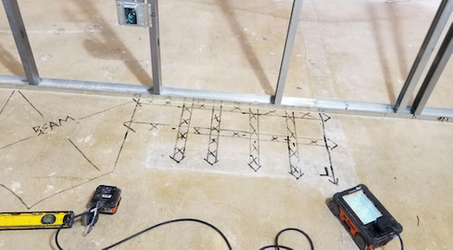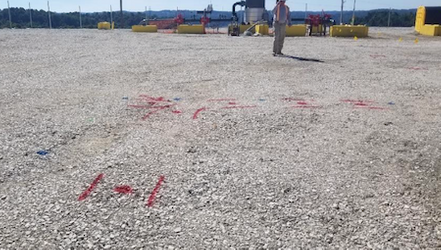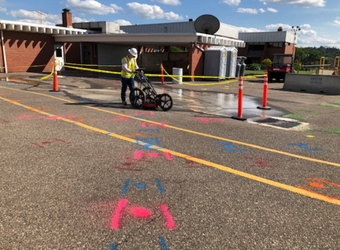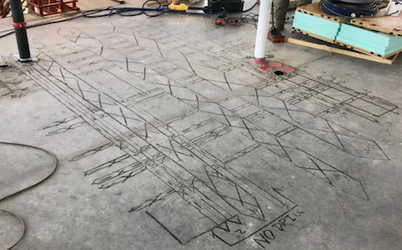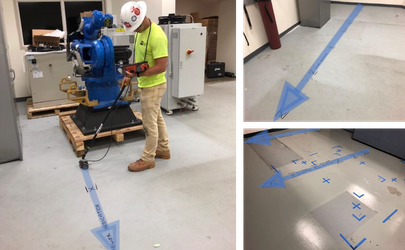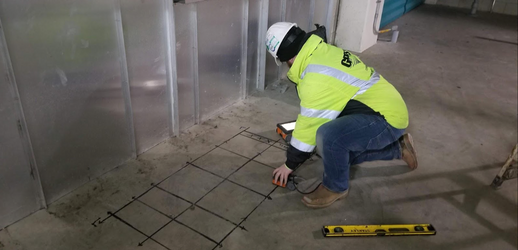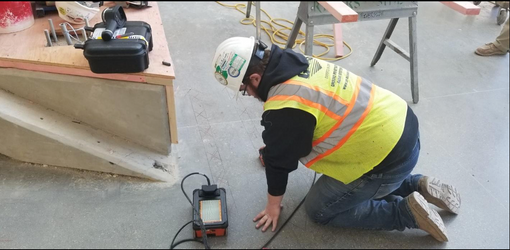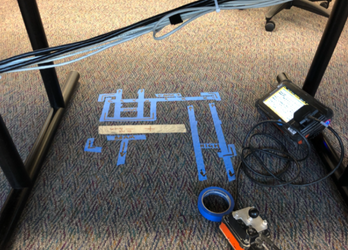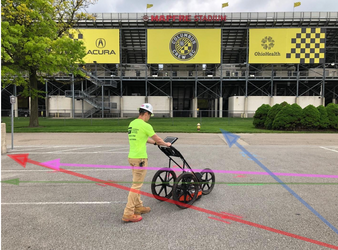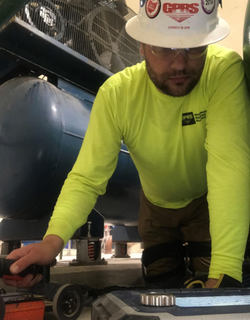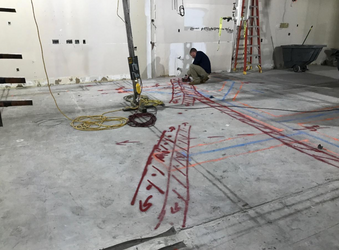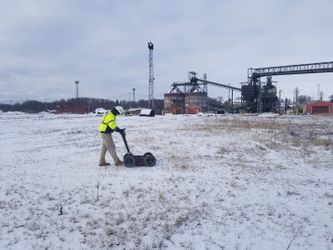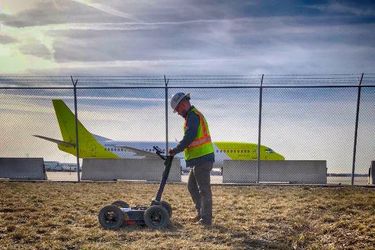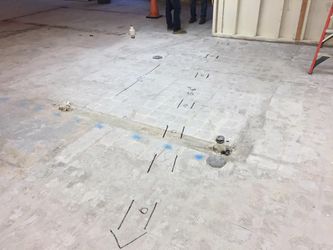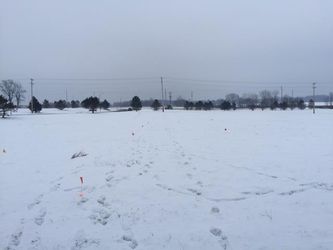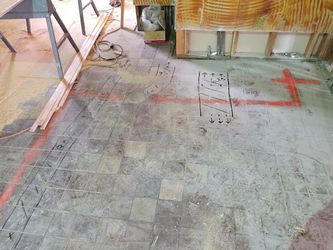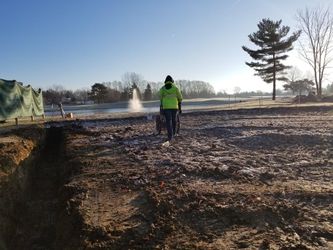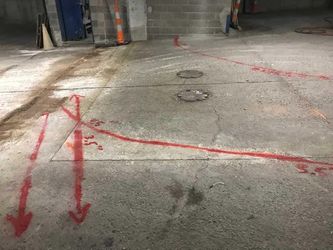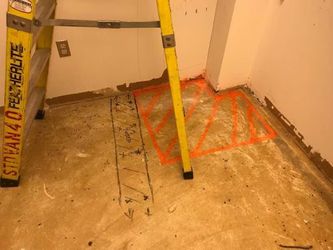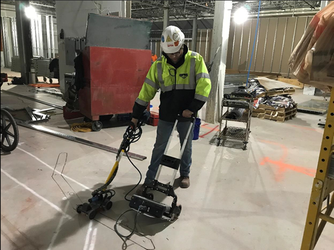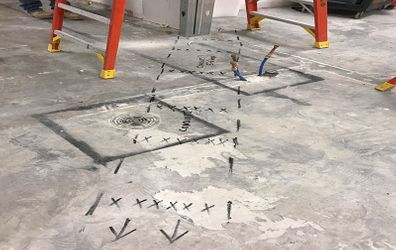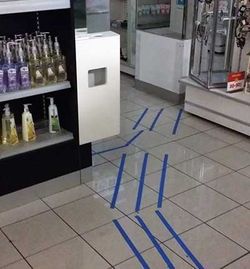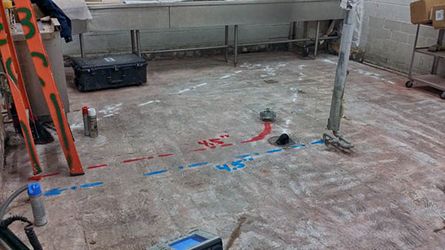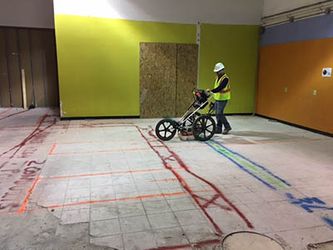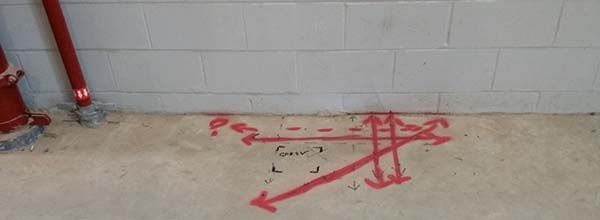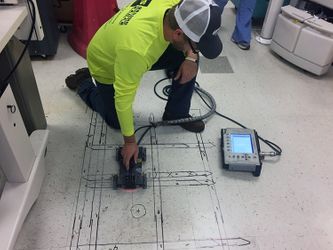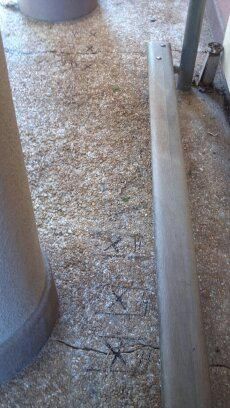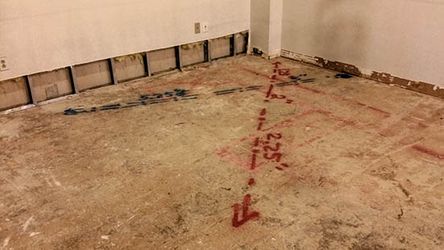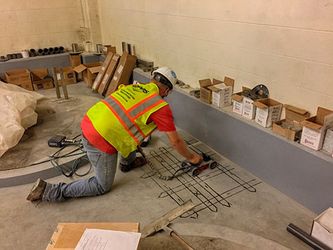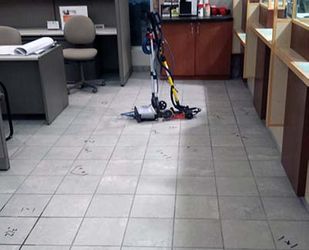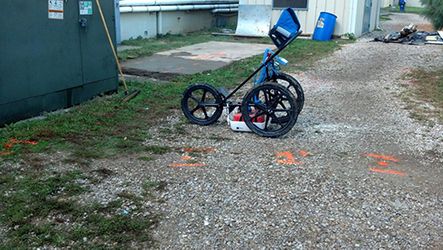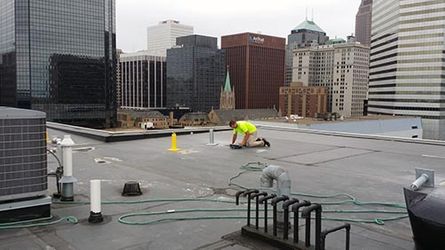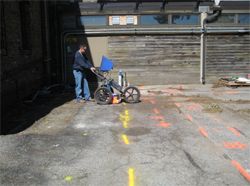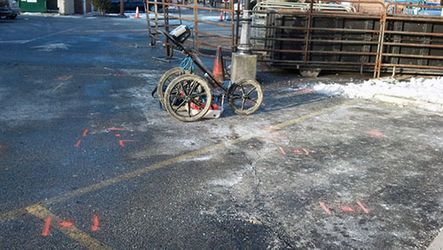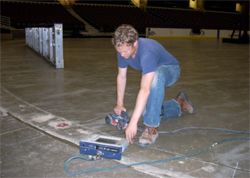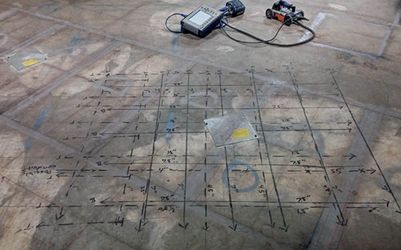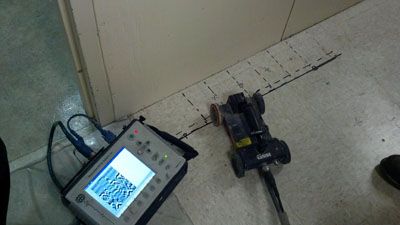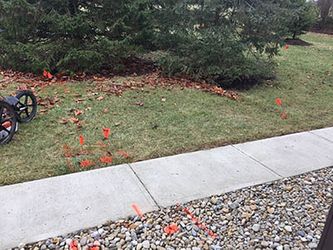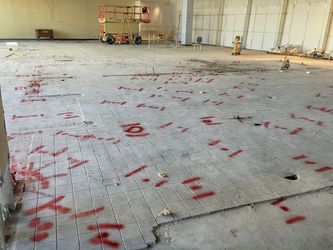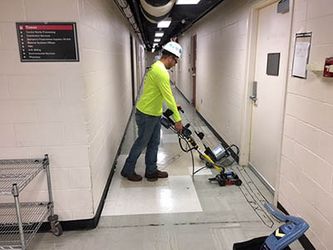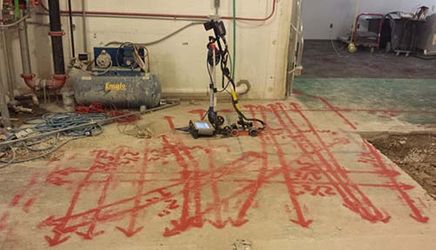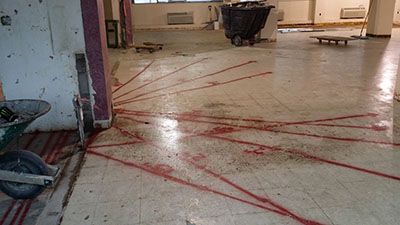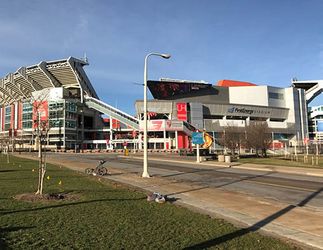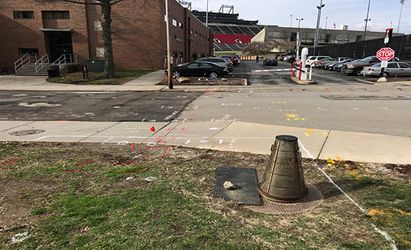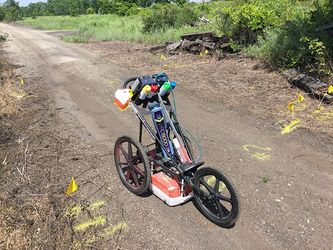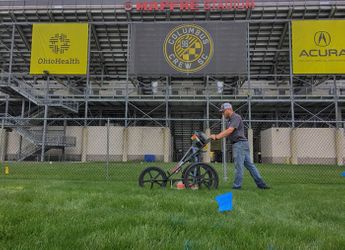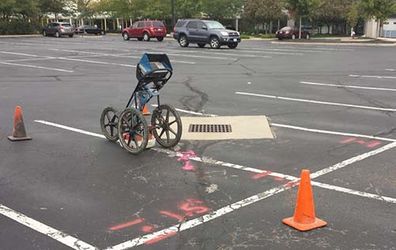Past Project Archive
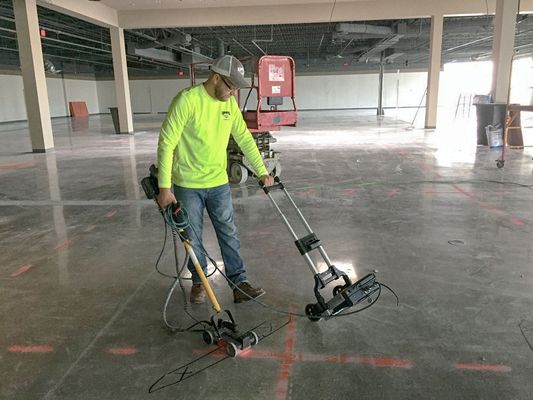
Featured Concrete Scanning Story
GPRS Scans For Conduits Prior To Saw Cutting
Ground Penetrating Radar Systems was recently called by a local contractor to a building renovation project in Columbus, Ohio. The scope of work was to identify and mark any conduits that may be cut during saw cutting. The contractor needed to avoid damaging any conduits so they would not waste time or money repairing them. GPRS, LLC. was able to use GPR equipment to accurately locate and mark out several conduits that would have been struck during the saw cutting process.
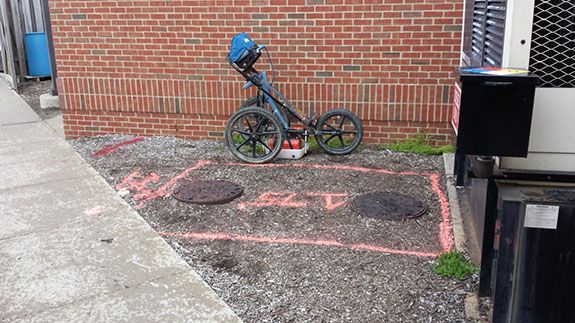
Featured Utility Locating Story
Scanning For Underground Storage Tanks (UST)
Ground Penetrating Radar Systems was recently called to a project by a local healthcare company in Columbus, Ohio. The scope of work was to scan a section of grass near an existing generator mapping out and locating and underground storage tank and other utilities before digging to put in a new fence.
Ground Penetrating Radar Systems was recently called out to a project Akron, Ohio. The scope of work was to scan several areas in roadways to clear utilities in advance of soil borings. By using GPR and Radio Detection several gas, water, sanitary and unknown lines were located. Had this area not been scanned prior to excavation several lines could have been struck. By having the area scanned beforehand, the client avoided timely delays and expensive repairs. GPRS, Inc. was able to complete the job in a timely manner to mark all utilities in the scanning area. GPR is an accurate and effective way of locating underground utilities, underground storage tanks, and voids.
For more information on how GPRS, Inc. can help you on your next project, please contact Cory Kennedy at 216-630-2903 or by email at cory.kennedy@gprsinc.com. We also have the capabilities of locating conduits, rebar, and post tension cables in a concrete slab.
GPRS does not provide geophysical, geological, land surveying or engineering services. If you need such services, please contact an appropriate professional.
moreGround Penetrating Radar Systems was recently called out to a project Akron, Ohio. The scope of work was to scan several acres for underground utilities. Using GPR and RD technologies GPRS was able to locate multiple water, gas, sanitary, storm, electrical and unknown lines in the scanning areas. Had this area not been scanned prior to excavation several lines could have been struck. By having the area scanned beforehand, the client avoided timely delays and expensive repairs. GPRS, Inc. was able to complete the job in a timely manner to mark all utilities in the scanning area. GPR is an accurate and effective way of locating underground utilities, underground storage tanks, and voids.
For more information on how GPRS, Inc. can help you on your next project, please contact Cory Kennedy at 216-630-2903 or by email at cory.kennedy@gprsinc.com. We also have the capabilities of locating conduits, rebar, and post tension cables in a concrete slab.
GPRS does not provide geophysical, geological, land surveying or engineering services. If you need such services, please contact an appropriate professional.
moreGPRS recently completed a utility investigation and locate in Dayton, OH on Colonel Glenn Highway. The project that GPRS was working on was being overseen by Star Construction for AT&T. The scope of the project was to scan approximately 1500 lineal feet to locate duct sections between specific manholes along the middle of the highway. Upon arrival GPRS met with Star Construction to walk the length of the proposed path of work to identify any potential hazards.
The main concern that the client had was getting accurate depths to lines within the duct banks, along with a depth to the top of the duct itself. The client needed accurate depths to mitigate any potential damages to the duct. Understanding the importance and accuracy of this, they reached out to GPRS and inquired about the mapping and CAD services we could provide.
After meeting with representatives from Star Construction and walking the site to identify potential hazards, GPRS needed to clarify the engineering controls and PPE to be used to safely complete the work. Being a fairly active highway, traffic controls would need to be provided and full PPE was established to instill maximum visibility while working. Star Construction was able to provide a vehicle to divert traffic away from GPRS as we worked, their help was vital in making sure the project went off without any incident.
moreGPRS (Ground Penetrating Radar Systems, Inc.) was recently hired by a local contractor during a project where they plan to build a new addition to an existing building. The contractor hired GPRS in order to locate any utilities in the proposed areas where excavation was to take place. The contractor contacted GPRS in order to determine where the existing utilities in these areas were located so they could make any necessary changes and plan accordingly based upon the located utilities. The contractor also planned to intercept certain utilities such as gas and water to tie new services into the existing lines. Once GPRS arrived at the site, our project managers walked the areas of concern (areas to be scanned) based upon a map of the proposed areas the client sent prior to scanning. This was done in order to determine what utilities were present on the surface in the areas being scanned. Upon completing the walk-through of the areas of concern, the project managers first used the EM Pipe Locator and walked the areas to get a general idea of where utilities which contained either an electrical, or communications signal were present. Once this initial phase was completed, the project managers were ready to scan using Ground Penetrating Radar (GPR). The GPR is pushed across the scan boundaries in a grid pattern to identify underground obstructions. The approximate depths of utilities present in the area were confirmed using GPR and marked directly on the surface using spray paint. Utilities such as gas, electric, communication, water, storm, and sanitary were found on this site. In the first image our project manager Josh Domingues is seen using GPR to confirm the approximate depth of the water line that the client had to intercept in order to add an additional service line.
moreGround Penetrating Radar Systems was recently called by a local construction engineering firm to help analyze a concrete slab for future construction planning. The contractor needed to know information such as slab thickness, rebar spacing, and conduit presence. The building was extremely old and little information about the slab composition exists. GPRS was able to identify the information the client was looking for as well as mark additional obstructions such as beams and conduits that were not thought to be present. Ground Penetrating Radar Systems was able to identify clear areas where the contractor could safely drill and take a core sample for further testing. The relevant details of the slab were then saved, and a detailed report was handed over to the client with the findings. All this information prevents delays on the project and keeps people safe. Striking a conduit can cost a contractor thousands of dollars in repairs, as well as potentially harming the workers drilling on site. Ground Penetrating Radar Systems, Inc. was able to get to the job in a timely manner which allowed the contractor to stay on schedule. GPRS can also perform after hours services upon request to meet our client’s needs.
moreChange order! What!? The slab has already been poured, and the customer wants to change the entire layout? Impossible! It’s a Post Tension Cable slab; can’t do it!
Unless you call GPRS! We specialize in identifying Post Tension Cables in the slab and can mark safe places to drill and areas that need to be avoided, so the integrity of the slab is not compromised.
In the picture below, a change order came across the desk of the General Contractor. Planters were now being added to a Post Tension Cable elevated slab. This required over 100 rebar dowels to be drilled 5” into the 8” slab on multiple balconies.
GPRS showed up and completed the job-specific safety training and scanning all in one day. There were over 45 cables encountered in the pathway of the new planters. Now they know both exactly where the cables are located, and how deep the cables are from the top surface of the slab at each encounter.
As it turns out, the surface had recently been waterproofed with a black tar. GPRS normally marks on surface with black permanent marker, crayon, or painter’s tape, but in this case, the marker just blended into the tar. Thankfully, every scanner is a concrete scanner and a utility locator. As utility locators, we carry crates full of paint. A quick trip to the truck, and the location of the Post Tension Cables were clearly painted on the surface.
moreGPRS (Ground Penetrating Radar Systems, Inc.) was recently hired by a local contractor to scan for any utilities in several areas where they planned to build new cooling towers and expand both ends of an existing building. Prior to our arrival, the contractor indicated the areas to be scanned by marking the four corners of the perimeter in white paint. Once we arrived, we walked the site with the onsite contact and discussed where they planned to excavate inside of the scanning boundary as well as how deep they planned on digging for the new foundations/piping. This was done in order to determine exactly what areas needed scanning and to get an idea of how deep we should scan for utilities, which helps us utilize our time on-site most efficiently. Upon completing the walk-through with the customer, we first used our EM Pipe Locator and walked the proposed area to get an idea of any live communication or electrical signals present within the areas to be scanned. Once we were ready to scan, we set-up and calibrated our 350MHz antenna and GSSI SIR-4000 unit at the area to be excavated and began scanning. During our scanning, we marked all findings on the surface using the appropriate color of paint and flags (where able to). The image below depicts our Toledo/NW Ohio Senior Project Manager, Justin Rasanow, scanning a section within an area requested to be scanned. The remaining two images depict on-site photos of an area that was scanned with the located utilities indicated on the surface. It is important to call GPRS and have each area being excavated scanned with GPR prior to any work being done. In this case, we were able to help the contractor avoid possibly excavating through numerous electrical conduits, as well as existing cathodic protection wires. Upon the completion of our scanning and explanation of our markings to the site contact, the contractor was able to determine where they should dig more cautiously when excavating the area.
moreGround Penetrating Radar Systems (GPRS) was recently called out to a project by a construction company to locate private and public utilities for a project on the north end of an active high school. The scope of the project was to locate any and all underground utilities in a 3,500 square foot area prior to trenching for new poles to be placed for overhead lines, and a new electrical line that is being installed underground. By using GPR and Radio Detection, GPRS was able to mark the entire area of all obstructions or impediments in the ground that could become dangerous while trenching. If the contractor had decided against calling GPRS, they potentially would have hit a fiber optic line up to 3 times, and existing electrical twice while trenching to install one new line. GPRS marked all utilities on site with spray paint and pin flags and included specific depths of each line found underground as well. GPR and Radio Detection is an accurate and effective way of locating underground utilities, vaults, tunnels, and other obstructions prior to any ground excavation. This project was a vital first step for the contractor to ensure the safety of all employees, and also helped establish a clearer timeline that avoids stoppages due to utility strike incidents. The scheduling of the project went extremely smooth for all sides, and was performed by one technician for best communication practice.
moreOn September 9, 2019, GPRS was requested to come on site by a general contractor to perform a Ground Penetrating Radar (GPR) scan at a bridge that is being completely remade from scratch high above a set of train tracks. The contractor was looking to see exactly how much concrete coverage was poured over the reinforcement. The contractor needed to know if the bridge was poured correctly to meet standards with at least 2.5” over every piece of reinforcement in place. GPRS found the coverage never met these depths, and the actual depths were far from acceptable. These major problems could severely risk the safety of everyone driving over the bridge in the future. The actual depths were written in black marker on the surface and located every 9-12 feet down the entire 150’ bridge. GPRS was even able to designate the specific depths and test drilled to ensure accuracy to within 1/8”. Without having GPRS on site there could have been serious damage to the bridge in the future. Our work prompted the contractor to begin plans on a major corrective action to ensure safety. Minimizing risks to your employees should always be a top priority of all companies, and GPRS aims to assist in that goal for every client we work for. Before you saw cut or core drill, call GPRS to know what’s underground and in the concrete slab you are working on!
moreGPRS was recently called out to a project by a general contractor at an RTA facility in Cleveland, Ohio. The scope of work was to locate any underground utilities in the vicinity and in conflict with a new trench that is planned to be installed. The contractor needed to excavate about a 1000ft trench. By using GPR and Radio Detection, we were able to locate utilities that the contactor desired. We were able to locate utilities such as electrical conduits (marked red in picture to the right), within the area of interest, from site lighting poles towards the buildings, and electrical conduits feeding the track switches and traffic control light signals. Electrical conduits were at about 2’ below the surface. Drains were also located.
The most exciting find was a conduit that crossed the trench path, shown in the picture below, that the contractor was unaware of and which would surely have been hit while trenching.
Why dig not knowing where any utilities are when GPRS can locate and mark all utilities with depth indications for your safety!
For more information on how GPRS can help you on your next project, please contact Vanja Dezelic at 440.344.5384 or by email at vanja.dezelic@gprsinc.com. We also have the capabilities of locating conduits, rebar, voids, and post tension cables in a concrete slab
moreGPRS (Ground Penetrating Radar Systems Inc.) was hired by Ohio State University (OSU) to locate utilities running through their laser labs, inside their robotic welding and additive manufacturing research building. GPRS was able to locate utilities running through the area, as well as the type of reinforcing within the concrete and the concrete slab thickness.
Pictured below is a GPRS Project Manager scanning in front of Ohio State's new robotic laser welding system, the installation of which would not have been possible without quality ground penetrating radar scans provided by GPRS. This robot will be used for cutting edge robotic welding and additive manufacturing research. The system features a 6- kilowatt laser head equipped with the latest laser beam raster and waveform technology, as well as a wire arc system enabling extremely high productivity hybrid laser-arc welding.
GPRS’s findings changed OSU’s plan regarding placement of the lasers. GPRS was able to highlight possible structural integrity issues as well as locate utilities near the proposed locations. For example, the concrete was reinforced with wire mesh, rather than rebar, which is preferable for such heavy equipment. OSU is now conducting research into how they could increase the structural integrity of the areas where the lasers are due to be placed. Without GPRS, these lasers may have been bolted to inappropriately reinforced concrete.
moreGround Penetrating Radar Systems was recently contracted to complete a site investigation prior to the installation of new ground wires in an active substation. The substation was going to be staying active through most of the project and delays due to utility damages or other line-strike issues were a major cause of concern to the General Contractors on site.
GPRS was tasked with locating any underground utility on site such as: electric, drain, and ground grid. We provided the location of each utility with as much accuracy as possible and gave depth where applicable. The technologies used on this project included the standard locating equipment (400 MHz antenna and EM locator.)
Site photos taken of a new utility trench with ground grind located and identified in green, and electrical conduit identified and marked in red. When we arrived on site, we discussed what needed to be done and walked the site. The contact conveyed that their primary objective was to have us locate the ground grid so that they could install new grounding and tie into the existing; we were shown two utility trenches in which this needed to be done. Providing this knowledge to the general contractor let them stay on schedule and prevent any possible injuries from a line strike.
moreGround Penetrating Radar Systems was recently called by a local electrician to help assist in the installation of a couple concrete core drilling locations in Columbus, Ohio. The electrician needed to core drill through the slab to install a couple conduits. Ground Penetrating Radar Systems was able to identify clear areas as well as mark and identify reinforcing steel located in the slab. Providing the electrician with as much information as we can directly assists with a safe and speedy project. While we identified multiple obstructions throughout their area of concern, we were also able to tell them an approximate slab thickness. All this information prevents delays on the project and keeps people safe. Striking a conduit can cost a contractor thousands of dollars in repairs, as well as potentially harming the workers drilling on site. Ground Penetrating Radar Systems, Inc. was able to get to the job in a timely manner which allowed the contractor to stay on schedule. Ground penetrating radar is an accurate and effective way of locating conduits, rebar, and post tension cables in a concrete slab.
Below you will find our standard markings for this project, we used sharpie to ensure a lasting deliverable in case of other delays on the project. We were able to identify several open areas for the general contractor to core drill through safely. We believe that all these marks represent possible rebar locations but conveyed to the contractor that these could be possible conduits and to be safe they should stay a minimum of 1”-2” off all our marks. By doing this we can ensure an efficient drilling process by avoiding the steel, beams, and conduits in the slab. This helps keep the project on schedule and prevents any unnecessary injuries that could be caused by striking a conduit with a drill. Since GPRS was able to arrive on site quickly and identify potential hazards in the slab prior to core drilling the general contractor was able to safely and efficiently core through the locations they needed.
moreGround Penetrating Radar Systems was recently called by a local electrician to help assist in the installation of a couple concrete core drilling locations in Columbus, Ohio. The electrician needed to core drill through the slab to install a couple conduits. Ground Penetrating Radar Systems was able to identify clear areas as well as mark and identify reinforcing steel and beams located in the slab. Providing the electrician with as much information as we can directly assists with a safe and speedy project. While we identified multiple obstructions throughout their area of concern, we were also able to tell them an approximate slab thickness. All this information prevents delays on the project and keeps people safe. Striking a conduit can cost a contractor thousands of dollars in repairs, as well as potentially harming the workers drilling on site. Ground Penetrating Radar Systems, Inc. was able to get to the job in a timely manner which allowed the contractor to stay on schedule. Ground penetrating radar is an accurate and effective way of locating conduits, rebar, and post tension cables in a concrete slab.
Below you will find our standard markings for this project, we used sharpie to ensure a lasting deliverable in case of other delays on the project. We were able to identify several open areas for the general contractor to core drill through safely. We believe that all these marks represent possible rebar locations but conveyed to the contractor that these could be possible conduits and to be safe they should stay a minimum of 1”-2” of all our marks. We also identified several beams in our scans, we were able to mark these out and get the contractor to avoid these when drilling. By doing this we can ensure an efficient drilling process by avoiding the steel, beams, and conduits in the slab. This helps keep the project on schedule and prevents any unnecessary injuries that could be caused by striking a conduit with a drill. Since GPRS was able to arrive on site quickly and identify potential hazards in the slab prior to core drilling the general contractor was able to safely and efficiently core through the locations they needed.
moreGround Penetrating Radar Systems was recently contracted to complete a site investigation prior to the installation of new equipment at an active compressor pad. The compressor pad was going to be staying active through most of the project and delays due to utility damages or other line-strike issues were a major cause of concern the General Contractors on site.
GPRS was tasked with locating any underground utility on site such as: gas, electric, drain, and possible water lines. We provided the location of each utility with as much accuracy as possible and gave depth where applicable. The technologies used on this project included the standard locating equipment (400 MHz antenna and EM locator).
Site photos taken of what appears to be a wide-open area present in the existing compressor pad. When we arrived on site, we discussed what needed to be done and walked the site. The contact conveyed that this area was where they wanted to set the new equipment and that there wouldn’t be anything running through this area. During our investigation we located the main electrical line and several drains going through this area. Providing this knowledge to the general contractor let them stay on schedule and prevent any possible injuries from a line strike.
moreGPRS (Ground Penetrating Radar Systems Inc.) was hired by Kraton Polymers to scan in the vicinity of a burst water line inside their Chemical Plant before they excavated to fix it. The initial site contact thought that there was nothing that ran through the area but wanted to be sure by calling GPRS to double check for any utilities and to locate the waterline itself.
GPRS found several lines including water, fire water, storm, fiber, gas, nitrogen, and some unknown lines. We marked all these findings onto the asphalt along with their depths. We also created a map of the area which uses a Google Earth image as a reference map. We overlay all of our findings, which color code utilities by type (as with our spray paint) and have details such as depth and location method. Therefore, if the surface water were to wash away any of our markings, the customer still has a map with all line locations plotted. In the pictures below, a GPRS Project Manager is seen scanning in front of the burst pipe. You can see the color-coded paint sprayed along the surface for utility, resulting in quite a colorful piece of asphalt.
The main tools in our arsenal for utility locating are the 400 MHz GPR Antenna and the Electromagnetic Pipe Locator. GPR works by sending pulses of energy into a material and recording the strength and the time required for the return of the reflected signal. The total depth achieved can be as much as 8 feet or more with this antenna but can vary widely depending on the conductivity of the materials. The Electromagnetic Pipe Locator can detect the electromagnetic fields from live power or radio frequency signals. It can also be used in conjunction with a transmitter to connect directly to accessible metallic pipes, risers, or tracer wires. Depths achieved can be as much as 20 feet depending on the type of signal being traced or methods used.
moreA General contractor in Cincinnati, OH needed to core a drill hole at a major construction site downtown. Being that the core was for a new fire suppression system, the size of the core would be 10" in diameter. Knowing that this was a Post Tension slab and the risk of hitting a Post Tension cable was high, it needed to be scanned/X-rayed. GPRS, LLC. specializes in this application of work; identifying Post Tension cables and other reinforcement with depths and mapping out directly on the floor to ensure safe drilling locations. In this sensitive project, it is essential to know what is under you before you drill. GPRS, LLC. took the call and was mobilized to the new high-rise project site in downtown Cincinnati.
On Site, GPRS was able to quickly and accurately find the post tensioned cables and steel reinforcement that was within a 10'x10' area where the client wanted his core drilling location to be. Typically, when A client needs a core drilling location cleared, a 2'x2' area is scanned. In this situation, the core was much larger and the client asked if a larger area could be scanned. GPRS was able to do this with no hesitation. At a client's request; larger areas may be scanned, especially if there is a lot of room for adjustment with the core location. All findings within this area were marked directly on the surface along with depths. GPRS was able to then discuss the findings with the General contractor. Locations of the post tension cables/steel reinforcement, depths, and slab thickness were all deliberated to find a safe drilling location for the future fires suppression system. This project was a success, and GPRS was able to ensure the security of the structural integrity, along with the safety of others while work was performed.
moreGPRS (Ground Penetrating Radar Systems Inc.) was hired by Ohio State University (OSU) to locate utilities running through their laser labs, inside their robotic welding and additive manufacturing research building. GPRS was able to locate utilities running through the area, as well as the type of reinforcing within the concrete and the concrete slab thickness.
Pictured here is a GPRS Project Manager scanning in front of Ohio State's new robotic laser welding system, the installation of which would not have been possible without quality ground penetrating radar scans provided by GPRS. This robot will be used for cutting edge robotic welding and additive manufacturing research. The system features a 6 kilowatt laser head equipped with the latest laser beam raster and waveform technology, as well as a wire arc system enabling extremely high productivity hybrid laser-arc welding.
GPRS’s findings changed OSU’s plan regarding placement of the lasers. GPRS was able to highlight possible structural integrity issues as well as locate utilities near the proposed locations. For example, the concrete was reinforced with wire mesh, rather than rebar, which is preferable for such heavy equipment. OSU is now conducting research into how they could increase the structural integrity of the areas where the lasers are due to be placed. Without GPRS, these lasers may have been bolted to inappropriately reinforced concrete.
moreGround Penetrating Radar Systems was recently called by a local general contractor to help assist in the installation of a couple concrete core drilling locations in Columbus, Ohio. The contractor needed to core drill through the slab to install a couple conduits. Ground Penetrating Radar Systems was able to identify clear areas as well as mark and identify reinforcing steel and or potential conduits in the slab. Providing the general contractor with as much information as we can directly assists with a safe and speedy project. While we identified multiple obstructions throughout their area of concern, we were also able to tell them an approximate slab thickness. All this information prevents delays on the project and keeps people safe. Striking a conduit can cost a contractor thousands of dollars in repairs, as well as potentially harming the workers drilling on site. Ground Penetrating Radar Systems, Inc. was able to get to the job in a timely manner which allowed the contractor to stay on schedule. Ground penetrating radar is an accurate and effective way of locating conduits, rebar, and post tension cables in a concrete slab.
Above you will find our standard markings for this project, we used sharpie to ensure a lasting deliverable in case of other delays on the project. We were able to identify several open areas for the general contractor to core drill through safely. We believe that all these marks represent possible rebar locations but conveyed to the contractor that these could be possible conduits and to be safe they should stay a minimum of 1”-2” of all our marks. By doing this we can ensure an efficient drilling process by avoiding the steel and or conduits in the slab. This helps keep the project on schedule and prevents any unnecessary injuries that could be caused by striking a conduit with a drill. Since GPRS was able to arrive on site quickly and identify potential hazards in the slab prior to core drilling the general contractor was able to safely and efficiently core through the locations they needed.
moreGround Penetrating Radar Systems was recently called by a local environmental firm to help assist in locating existing radiant heating tubes in the slab prior to core drilling in Cincinnati, Ohio. The contractor needed to core drill through the slab to install railings. Ground Penetrating Radar Systems, Inc. was able to arrive on site in a quick manor and begin assisting the contractor with their needs which allowed the project to stay on schedule. The contractor conveyed that we needed to utilize crayon on this project to convey our findings but not permanently mark the slab. We also clearly marked scan boundaries using red crayon to accurately showcase the limits of ours scans. GPR is an accurate and effective way of locating conduits, rebar, and post tension cables in a concrete slab.
moreGround Penetrating Radar Systems - GPRS – completed a GPR (concrete scanning “x-ray”) service in Cincinnati, Ohio. When a customer needed to core drill in a post tension slab, they contacted Ground Penetrating Radar Systems to provide assistance. The client was wanting to core drill but was unsure of the post tension locations within the slab. Upon arrival, the customer walked us through the site and showed us all of the concerns.
After a walk through the customer showed us where they were planning to core drill and explained they needed every post tension cable located and marked. There were some conduits that if they encountered it and caused damage, it would have been extremely expensive and could cause serious harm to individuals. The other issue was post tension in the drilling locations, the cost of damaging this post tension could have been extremely damaging to the slab and costly also.
At GPRS we provide more than just one method of locating. This played a huge factor with this specific site. Reason being, there’s less of a chance of underground infrastructure being compromised, safety of the contractors doing the work, and the cost of repairs if something is damaged
moreGPRS (Ground Penetrating Radar Systems Inc.) was hired by Midcity Electric to mark out 12 core drilling locations on a pan decking slab, spread over two floors of the AEP high-rise office building in downtown Columbus, Ohio. GPRS marked highs and lows of the metal pan decking, as well as any conduits running through the concrete. We then recommended to the customer to drill through the highs of the pan decking, as we are better able to confirm the absence of conduits in the high portion of the metal sheets. The last picture below shows what pan decking looks like prior to having concrete poured over the top.
GPRS marked all the highs and lows and found several conduits. Furthermore, to the surprise of the customer, we also discovered that many of the locations of pan decking the customer had intended to drill into had beams running below it. Below are two examples of where we found beams running in both directions along the bottom of the concrete slab. Many of the core drilling locations had to be moved to prevent drilling into one of these foundational supporting structures.
The main tools in our arsenal for concrete scanning are the 1600 MHz GPR Antenna, the 2000 MHz GPR Antenna, and the Electromagnetic Pipe Locator. One of the benefits of calling GPRS for any concrete scanning or utility locating job is that we are specially trained in more than one method and utilize several different pieces of equipment to ensure our customers receive the most thorough and all-encompassing methodologies to perform our jobs to the highest standards possible.
moreThe highly anticipated Sonic Temple Art and Music Festival, located at Mapfre Stadium in Columbus, Ohio, featured a lineup led by multiplatinum artists: Foo Fighters, System Of A Down and Disturbed. During the preparation for the festival, Columbus Crew hired GPRS (Ground Penetrating Radar Systems Inc.) to find and locate all underground utilities in the surrounding areas and stadium parking lots. This was scheduled prior to teams moving in to drill holes into the ground in various locations for tent and fence posts.
GPRS located and marked gas lines, water lines, fire-water lines, site lighting, communication lines, and storm lines. We ensured no utilities were struck. To locate all the utilities we used two methods, each of which is preferable at finding certain utilities. When utilized in conjunction, they ensure a much more thorough utility locate than using one method alone. This is one of the benefits of calling GPRS for any utility locate or concrete scan; we are specially trained in more than one method to ensure our customers receive the most thorough and all-encompassing methodologies to perform our jobs to the highest standards possible.
moreGPRS was recently hired by a local contractor to scan a 10” thick, elevated slab in an equipment building at a local water treatment plant. Prior to our arrival, the contractor determined that there were four possible locations he wanted us to scan in order to run conduit through the slab to the floor below. The contractor planned to core three 2” diameter holes in each of the four locations scanned in order to run conduit to new equipment being installed on the floor below. Once we arrived, we walked the site where the proposed coring locations would take place in order to get an idea of what type of slab we would be scanning as well as if any visible conduits were going into the slab areas being scanned.
We also went to the floor below and above the floor being scanned to determine if the slabs were consistent on each floor. Once we were ready to scan, indicated the perimeter of the area being scanned using dash marks. We then set-up and calibrated our 1600MHz antenna and GSSI SIR-4000 unit at each of the four proposed areas and began scanning. During our scanning, we marked all findings on the surface using permanent marker or crayon per customer request. The image to the right depicts our Toledo/NW Ohio Project Manager, Justin Rasanow, scanning one of the four proposed locations requested by the contractor. The remaining two images depict on-site photos of areas that have been scanned with the anomalies and scanning boundary indicated on the surface. The markings with diagonal lines running through them indicate anomalies with characteristics of rebar. The wider markings with an “X” running through them indicate anomalies with characteristics of conduit.
moreGround Penetrating Radar Systems (GPRS) was requested to come on site by a general contractor to perform a Ground Penetrating Radar (GPR) investigation at a hospital that is preparing to have a brand new room put inside of the west wing of the building on the ground floor. The contractor is needing to saw cut several trenches to install new drain lines and electrical/communication conduits running through the renovation area. The contractor needed to know if there were any conduits or potential problematic areas to avoid when saw cutting through the concrete. These major problems could severely risk the safety of employees if not found prior to using a saw. GPRS located multiple electrical conduits that were in, and just below, the concrete slab that could have been easily saw cut through if the blade were set too deep by the worker performing the cutting. The conduits were marked on the surface with red spray paint, and also included depth indications so that the contractor could safely saw cut over or around them without hitting the conduits.
Also, just to be even more specific for the contractor, conduits that were found to be live were marked with solid edges on the surface, and conduits that were found to be cut off and abandoned were marked with dashed lines. All conduits should be avoided at all times regardless, but this gives even more notice for the contractor to be aware of findings and have an even higher comfort level when beginning saw cutting. GPRS also was able to locate a majority of the drain lines running under the slab as well and marked those with green spray paint to make sure the general contractor knows how to differentiate between findings.
moreGPRS (Ground Penetrating Radar Systems, Inc.) was recently hired by a local contractor to scan a concrete slab-on-grade areas in different sections throughout a major retail store. The contractor planned to cut and remove the existing slab in order to build a foundation for a new freezer. Prior to our arrival, the contractor began saw-cutting, but was then informed by the store manager that electrical conduits may be running under the slab in the area being saw-cut. Due to the fact that the contractor was performing this work after-hours to avoid loud noise within the store, we were called late at night to perform the scanning. GPRS was able to mobilize to the site and begin scanning within one hour of receiving the phone call. Once we arrived, we used our 1600MHz antenna and GSSI SIR-4000 unit to scan the area being cut, as this was the contractor’s main area of concern.
After scanning the main area of concern ground penetrating radar, we then proceeded to scan the other areas requested by the contractor. During our scanning, we marked all findings on the surface, including the depths to the tops of the anomalies found using permanent marker. During, and after scanning, we explained all our findings to the contractor so they could fully understand what our utility markings meant and adjust their plans accordingly.
moreGround Penetrating Radar Systems Ohio (GPRS Ohio) was recently called out to a project by an environmental company to locate utilities for a project on a 60+ acre lot inside of an active coal mine. The scope of the project was to locate any and all underground utilities for almost 50 soil boring sample locations to be drilled down 25+ feet. By using GPR and Radio Detection, GPRS was able to safely clear each specific location of any obstructions or impediments in the ground that could become dangerous while drilling. GPRS painted all utilities on site with spray paint and included depths of the lines found underground as well. GPR and Radio Detection is an accurate and effective way of locating underground utilities, vaults, tunnels, and other obstructions prior to any ground excavation. This project was a vital first step for the environmental company to ensure the safety of all employees, and also helped establish a clearer timeline that avoids stoppages due to utility strike incidents. The scheduling of the project went extremely smooth for all sides, and was performed by one technician for simplicity and best communication practice as well. Why would you risk digging underground without knowing where any utilities are in your designated area when GPRS has the ability locate and mark all utilities with depth indications for your safety!
moreGPRS recently completed a private utility locate at CVG International Airport in Hebron, KY. The scope of the project consisted of the addition and removal of entrance ramps from a highway, and the building of a new parking garage (designed to hold rental car companies much closer to the main terminal). When contacting us about this project, the contractor stated that they needed to determine as much of the underground infrastructure as possible due to this being an “exploratory option”, to determine if they would be able to continue with certain designs and plans previously engineered. They had a set of original blueprints from when the airport was designed but didn’t know anything about what underground infrastructure was still there, what had been removed, and exactly what had been installed from the get go etc.
moreGround Penetrating Radar Systems (GPRS) was requested on site by a general contractor to perform a Ground Penetrating Radar (GPR) survey. The contractor needed to saw cut a trench to install new sanitary lines to replace the existing sanitary. The contractor needed to know if there were any conduits in the area to avoid saw cutting through them. GPRS located a bank of live electrical conduits that were just below the concrete slab at 5” depth that would have been saw cut. The conduits were painted on the surface with depth indications so that the contractor could safely saw cut over or around them without hitting the conduits. The site had knowledge of the electrical conduits found, and were glad to confirm their location. Without GPRS on site there could have been serious damage to the electrical lines. GPRS also located the existing sanitary lines for the contractor so that they knew where they had to tie into existing sanitary. Before you saw cut or core drill, call GPRS to know what’s underground!
Ground Penetrating Radar Systems is the best way to ensure the locations of reinforcement and conduits prior to saw cutting/drilling through concrete. We also have the capabilities of locating underground utilities, UST’s, and voids. For more information on how GPRS, LLC. can help you on your next project, please contact Micah Stair at (330) 639-8933 or by email at micah.stair@gprsinc.com.
moreGround Penetrating Radar Systems was recently called out to a project by a general contractor at a state correctional facility in Grafton, Ohio. The scope of work was to locate any underground utilities for a trench where new communication conduit needed to be installed. The contractor needed to excavate a 575 ft trench. By using GPR and Radio Detection, main electrical power at 4’ deep, main communication line 3’ deep, and main gas line at 4’, supplying the facility.
moreGround Penetrating Radar Systems (GPRS) was requested to come on site by a general contractor to perform a Ground Penetrating Radar (GPR) investigation and survey at a gas station that is preparing to have a brand-new fast food restaurant put inside of the building. The contractor is needing to saw cut multiple trenches to install new lines running through the storefront.
moreGround Penetrating Radar Systems was recently called out to a project by a general contractor to locate utilities for a project at UPMC ballpark. The scope of the project was to locate any underground utilities for a new playing field to be installed after a bulldozer takes out the existing surface of the entire baseball field. By using GPR and Radio Detection, many utilities were located. Electric, communication, data, and drainage systems were all located in the area of concern. GPRS painted all utilities on site with spray paint and included depths of the lines as well. GPR and Radio Detection is an accurate and effective way of locating underground utilities, vaults, tunnels, and other obstructions prior to excavation.
moreGround Penetrating Radar Systems was recently called by a local contractor to locate underground utilities that may be struck during excavation in Columbus, OH. The scope of work was to identify and mark utilities that cross that may be in the area of a new foundation. The contractor was working outside of a golf course, and could not risk striking a utility. GPRS, LLC. was able to use GPR and EM locating equipment to accurately locate and mark out several utilities that would have been struck during the excavation process. GPRS, LLC. was able to get to the job in a timely matter so the project could remain on schedule. Not only was GPRS able to get to the job quickly we were also able to work safely without interrupting any other site activities. GPR is an accurate and effective way of utilities, underground storage tanks, and voids.
moreGround Penetrating Radar Systems was recently called by a local environmental firm to help assist in the installation of vapor pins in Columbus, Ohio. The contractor needed to core drill through the slab to install the pins. GPRS was able to identify clear areas as well as mark and identify reinforcing in the slab. The contractor was able to drill safely and avoid hitting any conduits or reinforcing in the process. GPRS, LLC. was able to get to the job in timely manner which allowed the contractor to stay on schedule. GPR is an accurate and effective way of locating conduits, rebar, and post tension cables in a concrete slab.
For more information on how GPRS, LLC. can help you on your next project, please contact Asher Coats at (419)261-4250 or by email at asher.coats@gprsinc.com. We also have the capabilities of locating reinforcing steel, conduits and voids in concrete.
moreGround Penetrating Radar Systems (GPRS) was requested on site by a general contractor to perform a Ground Penetrating Radar (GPR) survey at the Cathedral Parking Garage in Cleveland, Ohio. The contractor needed to remove about 20’x20’ section of concrete on the ground floor. The contractor needed to know if there were any conduits in the area to avoid saw cutting through them. GPRS located three live electrical conduits and one communications conduit that were just below the concrete slab that would have been saw cut. The conduits were painted on the surface with depth indications so that the contractor could safely saw cut over or around them without hitting the conduits. Without GPRS on site there could have been serious damage to the electrical and communications lines. Before you saw cut or core drill, call GPRS to know what’s underground!
moreGround Penetrating Radar Systems (GPRS) was requested on site by a general contractor to perform a Ground Penetrating Radar (GPR) survey at the Green Urology in Green, Ohio. The contractor needed to remove about four 4’x4’ sections of concrete on the ground floor. The contractor needed to know if there were any conduits in the area to avoid saw cutting through them. GPRS located three live conduits, three rebar and footers that were in or just below the concrete slab that would have been saw cut. The conduits were painted on the surface with depth indications so that the contractor could safely saw cut over or around them without hitting the conduits. Without GPRS on site there could have been serious damage to the unknown conduits. Before you saw cut or core drill, call GPRS to know what’s underground!
moreGround Penetrating Radar Systems was recently called by a local contractor to scan an existing space that was being renovated in Beaver Creek, Ohio. The contractor needed to saw cut the concrete slab in multiple areas to install new plumbing and electrical conduits. The space had been renovated, and there were no drawings that showed what utilities existed under or within the slab. Striking a conduit or shallow utility when saw cutting can be expensive to repair and dangerous for the contractors on site. GPRS was called to mark out any conduits or shallow utilities so the contractors could saw cut the slab without damaging any existing utilities. GPRS located several conduits or shallow utilities within the saw cutting areas. Some of these conduits were very shallow and could have been struck during saw cutting if they were not identified. GPRS was able to get to the job in a timely matter so the project could remain on schedule. Ground penetrating radar is an accurate and effective way of locating conduits, rebar, and post tension cables in a concrete slab.
moreGround Penetrating Radar Systems (GPRS) was requested on site by a general contractor to perform a Ground Penetrating Radar (GPR) scan at the Cleveland Clinic-Richard E Jacobs Health Center. The contractor needed to saw cut a trench to install new plumbing lines and remove existing drains. The contractor needed to know if there were any conduits in the area to avoid saw cutting through them. GPRS located two active electrical/data banks of conduits going directly through their saw cut area. The conduits were painted on the surface with depth indications so that the contractor could safely saw cut over or around them without hitting the conduits. The hospital had no drawings showing the banks of conduits. Without GPRS on site, the contractor would have saw cut through them as they were right at the bottom of the concrete slab. Before you saw cut or core drill, call GPRS to know what’s underground!
moreGround Penetrating Radar Systems (GPRS) was requested on site by a general contractor at Kohl’s to perform a Ground Penetrating Radar (GPR) scan. The contractor needed to saw cut several areas of the building, however prior to saw cutting, they wanted to have each area scanned.
Thanks to GPRS, LLC. the conduits were marked out to ensure no conduits would be hit. In addition to marking the results of the scan onto the project surface with blue tape, a drawing was also submitted to the contractor.
All conduits were marked out in areas of concern. Ground Penetrating Radar Systems is the best way to ensure the locations of reinforcement and conduits prior to cutting/drilling through concrete, and if you would like to learn how GPRS can assist you with your next project, please contact GPRS Project Manager, Micah Stair at (330) 639-8933 or by email at micah.stair@gprsinc.com. We also have the capabilities of locating rebar and post tension cables in a concrete slab along with any underground utilities.
moreGround Penetrating Radar Systems (GPRS) was requested on site by a general contractor to perform a Ground Penetrating Radar (GPR) scan at the University Hospital in Parma, Ohio. New sanitary lines were being placed in the dish room and the concrete floor needed to be saw cut in designated areas. Multiple electrical conduits, a water line, & sanitary lines were located. The water line as well as electrical conduits were just below the concrete slab and would have been saw cut. Each line that was located had depth indications so that the contractor knew how deep it was safe to saw cut. Call GPRS before you saw cut or core drill concrete and we will keep you safe!
moreGround Penetrating Radar Systems was called by a local contractor to conduct a concrete scan at a building renovation project in Columbus, OH. The scope of work was to locate and mark out any conduits that were in the proposed saw-cutting locations, as the project required the contractor to saw-cut several locations so that they could install new electrical conduits.
After discussing the scope of the project with the customer, GPRS Project Manager, Mitch Streight used GPR equipment to locate and mark out the conduits that were in the saw-cutting locations. During the scan, Mitch locate conduits that were embedded in the concrete, and the shallow utilities that were located just beneath the concrete slab. This project was completed this project in a timely matter so that the project could remain on schedule, and thanks to the accurate, and timely results that we provided to this contractor, the saw-cutting was finished without any issues.
For more information on how GPRS, LLC. can help you on your next project, please contact Mitch Streight at (614) 400-6889 or by email at mitch.streight@gprsinc.com. We also have the capabilities of locating underground utilities, underground storage tanks, and voids.
moreRecently, Ground Penetrating Radar Systems (GPRS) was requested on site by a general contractor to perform a Ground Penetrating Radar (GPR) scan at the Southerly Waste Water Treatment Plant. The purpose was to locate any conduits and rebar in the concrete slab. The contractor didn’t want to hit any rebar or electrical conduits during core drilling. All rebar and conduits were marked out in areas of concern and the general contractor was able to safely drill holes without hitting any rebar or conduits. Ground Penetrating Radar Systems is the best way to ensure the locations of reinforcement and conduits prior to saw cutting/drilling through concrete. The pictures above and to the right show electrical conduits (red paint) and rebar (black marker dashed lines) marked out on site where core drilling took place.
moreGround Penetrating Radar Systems was recently called by a local contractor to a renovation project at the Ohio State University in Columbus, Ohio. The scope of work on this project was to determine the location of any reinforcing steel or post tensions cables that could be cut during the core drilling process. GPRS, LLC. was able to use GPR equipment to accurately locate and mark out all reinforcing steel and post- tension cables in the proposed location allowing the contractors to core drill safely and maintain the building’s structural integrity. The contractor’s original location had to be moved, due to the reinforcing steel that would be struck when core drilling. GPRS, LLC. was able to get to the job in a timely matter so the project could remain on schedule. GPR is an accurate and effective way of locating conduits, rebar, and post tension cables in a concrete slab.
For more information on how GPRS, LLC. can help you on your next project, please contact Mitch Streight at (614) 400-6889 or by email at mitch.streight@gprsinc.com. We also have the capabilities of locating underground utilities, underground storage tanks, and voids.
moreGround Penetrating Radar Systems of NW Ohio recently assisted on a project where hollow core concrete needed repair. The contractor needed to locate the hollow cells to fill them with concrete to repair damaged sections of the slab. The cores were placed over the hollow areas to make openings to pump concrete into the cells without damaging any of the tensioned cables used for support.
Nondestructive testing such as ground penetrating radar is being required on more and more facilities nationwide because of its reliability and accuracy. Concrete imaging is 100% safe because it doesn't emit any radiation. Concrete radar technology also operates in real time, meaning that while the concrete is being scanned it can be mapped out almost instantly by the trained and certified GPRS technician. Ground penetrating radar is safer, faster and more accurate than traditional x-ray. For more information about this technology in NW Ohio/NE Indiana, contact Bo McGee (419) 481-6737 or bo.mcgee@gprsinc.com.
moreRecently, Ground Penetrating Radar Systems (GPRS) was requested on site by a general contractor to perform a Ground Penetrating Radar (GPR) scan at the Landmark building in Beachwood, Ohio. The contractor saw cut through a high pressure water line just under the slab and needed to locate the line as well as any conduits prior to additional saw cutting. GPR located the water line along with two conduits in the areas to be saw cut. The lines located were marked out on site with depth indications to be sure no lines would be saw cut. The contractor was able to safely expose the lines and saw cut the rest of the area. Call GPRS before you saw cut or core drill concrete and we will keep you safe!
moreGround Penetrating Radar Systems was recently called by a local contractor to a renovation project at the water treatment facility in Columbus, Ohio. The contractor needed to core drill through the slab to install new electrical services. GPRS marked out all reinforcing steel and conduits within the slab so that the contractor could avoid damaging conduits, and jeopardizing the integrity of the slab. GPRS, LLC. was able to get to the job in a timely matter so the project could remain on schedule. GPR is an accurate and effective way of locating conduits, rebar, and post tension cables in a concrete slab.
For more information on how GPRS, LLC. can help you on your next project, please contact Mitch Streight at (614) 400-6889 or by email at mitch.streight@gprsinc.com. We also have the capabilities of locating underground utilities, underground storage tanks, and voids.
moreGround Penetrating Radar Systems was recently called by a local construction company to a project at a PNC Bank in Columbus, Ohio. Scope of work was to scan a concrete slab on grade locating and mapping out conduits before saw cutting to run new conduits for electronic teller systems. After scanning with GPR, there were several conduits that were marked out in the area of saw cutting that would have been struck if it had not been scanned. GPRS, LLC. was able to get to the job in a timely matter and mark out all the conduits on the surface with a depth. GPR is an accurate and effective way of locating conduits, rebar, and post tension cables in a concrete slab.
For more information on how GPRS, LLC. can help you on your next project, please contact David Borcherdt at (614) 946-2120 or by email at david.borcherdt@gprsinc.com. We also have the capabilities of locating underground utilities, underground storage tanks, and voids.
moreGround Penetrating Radar Systems was recently called to a project by a local construction company in Columbus, Ohio. The scope of work was to scan a section of grass and an existing concrete slab locating and mapping out underground utility lines before excavating. There were several utility lines that were marked out using GPR that would have been struck during excavating. GPRS, LLC. was able to get to the job in a timely matter to map out the utilities so the project could stay on time. GPR is an accurate and effective way of locating underground utility lines, underground storage tanks, and voids.
For more information on how GPRS, LLC. can help you on your next project, please contact David Borcherdt at (614) 946-2120 or by email at david.borcherdt@gprsinc.com. We also have the capabilities of locating conduits, rebar, and post tension cables in a concrete slab.
moreGround Penetrating Radar Systems (GPRS) was requested on site by a general contractor to perform a Ground Penetrating Radar (GPR) scan. The purpose of this scanning project was to locate all of the post tension cables within a concrete slab. Multiple areas were scanned on the roof to ensure that the contractor would not hit any post tension cables during the anchor drilling process. All of the cables that were located in areas of concern were marked with their depth and location. Ground Penetrating Radar Systems is the best way to determine the exact locations of reinforcement and conduits prior to cutting/ drilling through concrete. If the contractor would not have had called GPRS: The Experts In GPR, they would have hit multiple cables in area shown below. Thanks to GPRS, LLC., all of the anchors were drilled and placed without any cables being hit.
For more information on how GPRS, LLC. can help you on your next project, please contact Micah Stair at (330) 639-8933 or by email at micah.stair@gprsinc.com. We also have the capabilities of locating rebar and conduits in a concrete slab along with any underground utilities.
moreWhen a contractor needed to verify that there was no rebar in the concrete in the area where they wanted to core drill they called Ground Penetrating Radar Systems. GPRS marked the Rebar directly onto the surface and since there is no radiation involved the occupied building didn’t need to be cleared of any workers. GPRS used ground penetrating radar for the concrete scanning to mark out the rebar. The GPRS Tech, Nate Kollar, was able to locate the reinforcing rebar and mark them directly on the surface with black marker. Since the results are immediate GPRS was able to complete the concrete scanning accurately and quickly.
For projects in Dayton and surrounding areas, contact Nate Kollar (937) 604-7802 or by email at nate.kollar@gprsinc.com.
moreThe Toledo Zoo has been a recurring customer of GPRS the past few years. Recently, their 70-year old museum was experiencing water damage to its northwest foundation wall and was flooding the basement on a frequent basis. The zoo decided that repairs were necessary and the foundation needed to be exposed and repaired.
The zoo decided to contract GPRS to perform a ground penetrating radar survey to locate underground utilities near the foundation wall so that no interruption or damage to existing utilities would be experienced during the excavation. Project leader Gary Balsom was concerned that the area had gas, electric, fiber optic, and other utilities that would be in the vicinity to the area. Toledo technician John Kessinger mobilized to the zoo on short notice and was able to identify and locate the underground pipes with the ground penetrating radar. Within just a few short hours, the entire area was surveyed and all the underground utilities were marked out onto the surface.
You can contact John Kessinger for Northwest Ohio at (419) 467-1444 or by email at john.kessinger@gprsinc.com.
moreGround Penetrating Radar Systems was recently called to a project Corna Kokosing in Columbus, Ohio near German Village. The scope of work was to scan a section of an asphalt parking lot locating and mapping out a water line and other underground utility lines before excavating to tap into the existing water line that needed to be identified. There were several utility lines including the water line that were marked out using GPR that would have been struck during excavating. GPRS, LLC. was able to get to the job in a timely matter to map out the utilities so the project could stay on time. GPR is an accurate and effective way of locating underground utility lines, underground storage tanks, and voids.
For more information on how GPRS, LLC. can help you on your next project, please contact David Borcherdt at (614) 946-2120 or by email at david.borcherdt@gprsinc.com. We also have the capabilities of locating conduits, rebar, and post tension cables in a concrete slab.
moreKGE Arena Seating Company needed to drill through concrete floor of the ice rink at Quicken Loans Arena in Cleveland, so they first called GPRS, LLC. KGE knew that there were pipes containing glycol embedded in the concrete. Instead of risking drilling through one of these pipes and disrupting the glycol pipe network, KGE first called GPRS to map out the pipes. Ground Penetrating Radar was able to map out the precise locations of each pipe and mark the locations directly onto the concrete surface at the time of the scanning. We were also able to identify the end of each loop of pipe and where they made each 180 degree turn. KGE was then able to confidently drill each anchor through the concrete.
moreGround Penetrating Radar Systems (GPRS) was requested on site by a general contractor to perform a Ground Penetrating Radar (GPR) scan at the Akron Children’s Hospital in Akron, Ohio. The contractor needed to know where the top and bottom rebar were for multiple locations on an elevated slab where core drilling was to be performed. GPRS also located an electrical conduit that could have been cored through in the concrete slab. The contractor was told there was no conduit in the slab. Call GPRS before you saw cut or core drill concrete and we will keep you safe!
moreWhen a contractor needed to verify that there were no conduits in the concrete in the area where they wanted to core drill they called Ground Penetrating Radar Systems. GPRS marked the conduits directly onto the surface and since there is no radiation involved the occupied building didn’t need to be cleared of any workers. GPRS used ground penetrating radar for the concrete scanning to mark out the rebar. The GPRS Tech, Nate Kollar, was able to locate the reinforcing rebar and conduits. GPRS then marked them directly on the surface with black marker. Since the results are immediate GPRS was able to complete the concrete scanning accurately and quickly.
For projects in Cincinnati and surrounding areas, contact Nate Kollar (513) 225-3076 or by email at nate.kollar@gprsinc.com.
moreGround Penetrating Radar Systems was recently called to a project by a local healthcare company in Columbus, Ohio. The scope of work was to scan a section of grass near an existing generator mapping out and locating an underground storage tank and other utilities before digging to put in a new fence. This was part of a grease trap that went to the kitchen just inside the building. GPRS, LLC. was able to get to the job in a timely matter to map out the existing storage tank. GPR is an accurate and effective way of locating underground utility lines, underground storage tanks, and voids.
For more information on how GPRS, LLC. can help you on your next project, please contact David Borcherdt at (614) 946-2120 or by email at david.borcherdt@gprsinc.com. We also have the capabilities of locating conduits, rebar, and post tension cables in a concrete slab.
moreA contractor in Columbus, Ohio contacted GPRS to scan a job site for utility lines prior to digging a trench for a new utility line. The contractor was working around a communications cell tower, and they could not risk hitting any utilities. After arriving on site, GPRS, LLC. was able to use GPR equipment to locate and mark out the utilities that would have been hit during the digging process. GPRS, LLC. was able to get to the job done in a timely matter so that the project could remain on schedule, and the contractor was able to use the results of the scan to complete their project without any issues.
GPR is an effective way to locate utilities prior to digging. For more information on how GPRS, LLC. can help you on your next project, please contact Mitch Streight at (614) 400-6889 or by email at mitch.streight@gprsinc.com. We also have the capabilities of locating reinforcing steel, conduits and voids in concrete.
moreGround Penetrating Radar Systems was recently called by a local contractor to a building renovation project in Columbus, Ohio. The scope of work was to identify and mark any conduits that may be cut during saw cutting. The contractor needed to avoid damaging any conduits so they would not waste time or money repairing them. GPRS, LLC. was able to use GPR equipment to accurately locate and mark out several conduits that would have been struck during the saw cutting process. GPRS, LLC. was able to get to the job in a timely matter so the project could remain on schedule. GPR is an accurate and effective way of locating conduits, rebar, and post tension cables in a concrete slab.
For more information on how GPRS, LLC. can help you on your next project, please contact Mitch Streight at (614) 400-6889 or by email at mitch.streight@gprsinc.com. We also have the capabilities of locating underground utilities, underground storage tanks, and voids.
moreGround Penetrating Radar Systems was recently called by a local contractor to a renovation project in downtown Columbus, Ohio. The scope of work on this project was to determine the location of any conduits, or utilities running within or below the slab, prior to saw cutting. The contractor did not want to damage, or replace any conduits during the process. GPRS, LLC. was able to use GPR equipment to accurately locate and mark out any conduits running through the proposed saw cutting area and marked them on the surface so that the contractor could avoid them. GPRS, LLC. was able to get to the job in a timely matter so the project could remain on schedule. GPR is an accurate and effective way of locating conduits, rebar, and post tension cables in a concrete slab.
For more information on how GPRS, LLC. can help you on your next project, please contact Mitch Streight at (614) 400-6889 or by email at mitch.streight@gprsinc.com. We also have the capabilities of locating underground utilities, underground storage tanks, and voids.
moreGround Penetrating Radar Systems was recently called by a local contractor to a new building construction project in Columbus, Ohio. The scope of work on this project was to determine the location of any reinforcing steel or post tensions cables that could be cut during the core drilling process. The contractor could not hit any reinforcing steel in order to maintain the structural integrity of the slab. GPRS, LLC. was able to use GPR equipment to accurately locate and mark out all reinforcing steel in the proposed locations allowing the contractors to core drill safely and maintain the building’s structural integrity. GPRS, LLC. was able to get to the job in a timely matter so the project could remain on schedule. GPR is an accurate and effective way of locating conduits, rebar, and post tension cables in a concrete slab.
For more information on how GPRS, LLC. can help you on your next project, please contact Mitch Streight at (614) 400-6889 or by email at mitch.streight@gprsinc.com. We also have the capabilities of locating underground utilities, underground storage tanks, and voids.
moreWhen Net Jets, a Berkshire Hathaway company, decided to add pillars to the new mezzanine area, they had concerns that the existing concrete would not be thick enough to support each of the six pillars. In order to accurately determine the thickness and verify proper steel reinforcing in the Port Columbus International Airport facility, Net Jets called, Ground Penetrating Radar Systems in Dayton, Ohio. On site GPRS was able to precisely identify the thickness of the concrete slab and determine the flooring contained adequate reinforcing for the proposed remodel. Furthermore, because Net Jets was so impressed at the speed and accuracy of our GOR survey, they asked us to verify the thickness of the concrete in each of the rooms in the general hangar and support facility. There is no radiation hazard associated with GPR, the scanning could take place during a normal working day without removing any employees from the premises.
Nate Kollar runs GPRS operations in the Greater Cincinnati, Columbus and Dayton, Ohio region including Indianapolis and Southern Indiana, all of Kentucky and West Virginia. He is based in Dayton, Ohio and he can be reached at (937) 604-7802 or by email at nate.kollar@gprsinc.com. Concrete and asphalt slab thickness and reinforcing verification is a common service performed by the GPR technicians at GPRS.
moreWhen Harlem Township in Delaware County, Ohio took control of a cemetery dating back to 1830, they needed to make sure they had as much information about what was under the ground as possible. The township government decided to use Ground Penetrating Radar Systems and Nate Kollar from the Columbus, Ohio office to create a map and give the trustees important data to help them best serve the families of those buried in the cemetery. Using a Ground Penetrating Radar 400MHz antenna with a maximum effective range of 3.5 meters GPRS was able to accurately report that there were no unknown graves on the site. GPRS was also able to locate the direction of grave sites marked with headstones.
Nate Kollar runs GPRS operations in the Greater Cincinnati, Columbus and Dayton, Ohio region including Indianapolis and Southern Indiana, all of Kentucky and West Virginia. He is based in Dayton, Ohio and he can be reached at (937) 604-7802 or by email at nate.kollar@gprsinc.com. Cemetery mapping and grave site location and verification is a common service performed by the Ground Penetrating Radar technicians at GPRS.
moreGround Penetrating Radar Systems was recently called by a local contractor to a renovation project in Westerville, OH. The contractor was core drilling in order to install new electrical feeds near the columns of the building, and needed to know where they could safely core through the slab. The slab featured pan decking construction; this means that we will mark out the high and low areas and recommend that the contractor drill only in the high locations to avoid hitting a conduit in the low areas of the pan. GPRS, LLC. was able to use GPR equipment to accurately locate and mark the high and low portions of the pan decking, a structural beam, and conduits running across the floor. GPRS, LLC. was able to get to the job in a timely matter so the project could remain on schedule. GPR is an accurate and effective way of locating conduits, rebar, and post tension cables in a concrete slab.
For more information on how GPRS, LLC. can help you on your next project, please contact Mitch Streight at (614) 400-6889 or by email at mitch.streight@gprsinc.com. We also have the capabilities of locating underground utilities, underground storage tanks, and voids.
moreGround Penetrating Radar Systems was called by a local contractor to scan the floor of an existing building prior to the installation of new sanitary lines. The scope of this project was to determine the locations of conduits and/or shallow utilities so that the contractor could perform their planned saw-cutting. The contractor wanted to avoid any repair costs, or lost time on the project, and they knew that if they called GPRS, they would be able to saw-cut without any issues.
During the scan, we located, and marked out several conduits that were running in the area of the proposed trench, and the results of the scan were marked directly onto project surface.
GPR is an accurate and effective way to locate items such as conduits, rebar, and post tension cables in concrete slabs. Additionally, GPR is a great way to locate underground utility lines and other near-surface items.
For more information on how GPRS, LLC. can help you with your next project, please contact Mitch Streight at (614) 400-6889 or by email at mitch.streight@gprsinc.com.
moreGround Penetrating Radar Systems was recently called by a local construction company to a project at Nationwide Children’s Hospital in Columbus, Ohio. Scope of work was to scan a concrete slab on grade locating and mapping out conduits before saw cutting to tie into an existing sanitary line. After scanning with GPR, there were several conduits that were marked out in the area of saw cutting that would have been struck if it had not been scanned. GPRS, LLC. was able to get to the job in a timely matter and mark out all the conduits on the surface with a depth. GPR is an accurate and effective way of locating conduits, rebar, and post tension cables in a concrete slab.
For more information on how GPRS, LLC. can help you on your next project, please contact David Borcherdt at (614) 946-2120 or by email at david.borcherdt@gprsinc.com. We also have the capabilities of locating underground utilities, underground storage tanks, and voids.
moreGround Penetrating Radar Systems (GPRS) was requested on site by a general contractor to perform a Ground Penetrating Radar (GPR) scan in Lakewood, Ohio. The purpose was to locate any conduits in or just below the concrete slab prior to saw cutting. Many conduits were located and marked out with depths in the area of concern. The contractor was doing demolition inside the building and wanted to use existing conduits without saw cutting through them. Ground Penetrating Radar Systems is the best way to ensure the locations of reinforcement and conduits prior to saw cutting/drilling through concrete. The pictures show all of the conduits located with depths to ensure that no conduits would be hit when saw cutting.
moreGround Penetrating Radar Systems was contacted to conduct a utility scan just outside the First Energy Stadium in Cleveland, Ohio. The scope of the scan was to locate any underground utilities for a new pole location that needed to be installed. By using GPR and Radio Detection, a gas line, electrical lighting conduit, and communication duct bank were located in the area of concern. GPRS was able to designate areas to safely install new pole locations. GPR and Radio Detection is an accurate and effective way to locate underground utilities prior to excavation. Give us a call prior to your next project and we will find what’s below the ground.
For more information on how GPRS, LLC. can help you on your next project, please contact Micah Stair at (330) 639-8933 or by email at micah.stair@gprsinc.com.
morePrior to installing a steam line at Youngstown State University, a construction contractor contacted GPRS to conduct a utility scan.
After arriving to the job-site, we scanned the area with both GPR and Radio Detection to locate all of the utility lines at the site. During the scan, we located utility lines such as electrical, communication, chilled water, steam, sanitary, storm, and fire. Next, in addition to locating the site’s utility lines, during the scan, we located an underground storage vault, and an underground tunnel (which were connected to each other). As we scanned the job-site, we marked the results of the scan onto the project surface with spray paint and flags. Then, once the scan was finished, since the contractor needed to have long term record of the scan results, we provided them with both a CAD overlay, and a Google Maps image (both of which depicted the results of the scan).
moreGround Penetrating Radar Systems was recently called by an environmental firm to locate any utilities prior to soil boring. The contractor was working within a gas pipeline facility, and risked hitting several utilities. Some of these lines are critical to the operation of the facility, and could have major repair costs, or cause serious injury if they are struck. GPRS, LLC. was able to use GPR equipment and Radio Detection to accurately locate and mark out several utilities that would have been struck during the drilling process. GPRS, LLC. was able to get to the job in a timely matter so the project could remain on schedule. GPR is an accurate and effective way of utilities, underground storage tanks, and voids.
For more information on how GPRS, LLC. can help you on your next project, please contact Mitch Streight at (614) 400-6889 or by email at mitch.streight@gprsinc.com. We also have the capabilities of locating reinforcing steel, conduits and voids in concrete.
moreGround Penetrating Radar Systems was contacted by a facilities manager to conduct a private utility locate at the Columbus Crew SC arena. The facilities manager was planning to install a fence for a concert, however they wanted to have the project area scanned before they got started with their project. The scope of this scan was to locate, and mark out the utility lines in the area so that the required drilling for the fence install could be performed.
During the scan, GPRS Project Manager, Mitch Streight scanned the area, and located / mark out all of the utilities lines on the area.
Thanks to our quick response time and detailed & accurate work, once the scan was finished, the facilities manager used the results of the scan to move forward with the fence install project, and they were able to perform the required drilling without any issues.
GPR technology is an affordable, and effective way to locate near-surface items such as underground utility lines, underground storage tanks, and voids. GPR technology can also be used to scan concrete slabs for rebar, conduits, and other near-surface items.
For more information on how GPRS, LLC. can help you on your next project, please contact Project Manager, Mitch Streight by phone at (614) 400-6889 or by email at mitch.streight@gprsinc.com.
moreGround Penetrating Radar Systems was recently called to a project at an IBM office building by a local construction company in Columbus, Ohio. The scope of work was to scan several sections of an asphalt parking lot, locating and mapping out underground utility lines before excavating to repair drain lines. There were several utility lines that were marked out using GPR that would have been struck during excavating. GPRS, LLC. was able to get to the job in a timely matter to map out the utilities so the project could stay on time. GPR is an accurate and effective way of locating underground utility lines, underground storage tanks, and voids.
For more information on how GPRS, LLC. can help you on your next project, please contact David Borcherdt at (614) 946-2120 or by email at david.borcherdt@gprsinc.com. We also have the capabilities of locating conduits, rebar, and post tension cables in a concrete slab.
more


![screen-11.48.37[08.04.2020].png](https://static.spacecrafted.com/bdb3c18a9f2041f7a977423ca88744f8/i/a0bbf25fe4fc41ae9d1cd3a8f39f427f/1/4SoifmQpDrHbZJ6Vvf4aQ/screen-11.48.37%5B08.04.2020%5D.png)
![screen-13.54.02[01.04.2020].png](https://static.spacecrafted.com/bdb3c18a9f2041f7a977423ca88744f8/i/cbbd5cb0e6c540a0af3bd4bea73c10bc/1/4SoifmQpDrHbZJ6Vvf4aQ/screen-13.54.02%5B01.04.2020%5D.png)
![screen-13.52.18[01.04.2020].png](https://static.spacecrafted.com/bdb3c18a9f2041f7a977423ca88744f8/i/ee7ac2b0820f4d14bae386c66bbe896d/1/4SoifmQpDrHbZJ6Vvf4aQ/screen-13.52.18%5B01.04.2020%5D.png)
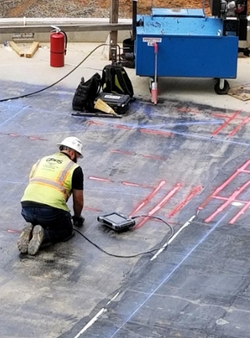
![screen-16.13.11[14.10.2019].png](https://static.spacecrafted.com/bdb3c18a9f2041f7a977423ca88744f8/i/d9a3f5b3224648528df00d49a2b03301/1/4SoifmQpDrHbZJ6Vvf4aQ/screen-16.13.11%5B14.10.2019%5D.png)
![111screen-13.00.35[30.09.2019].png](https://static.spacecrafted.com/bdb3c18a9f2041f7a977423ca88744f8/i/e8c6b60c3148402084560408c5efb454/1/4SoifmQpDrHbZJ6Vvf4aQ/111screen-13.00.35%5B30.09.2019%5D.png)
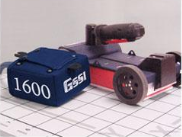
![5screen-16.15.19[23.09.2019].png](https://static.spacecrafted.com/bdb3c18a9f2041f7a977423ca88744f8/i/e9bea52707184aba8c960983be187207/1/4SoifmQpDrHbZJ6Vvf4aQ/5screen-16.15.19%5B23.09.2019%5D.png)
![11screen-11.23.34[19.09.2019].png](https://static.spacecrafted.com/bdb3c18a9f2041f7a977423ca88744f8/i/c2cf021a1d4a43cc9aeb9edc77f20cd0/1/4SoifmQpDrHbZJ6Vvf4aQ/11screen-11.23.34%5B19.09.2019%5D.png)
![1screen-11.13.33[19.09.2019].png](https://static.spacecrafted.com/bdb3c18a9f2041f7a977423ca88744f8/i/d9d2e521409f43f2b2df35ab343c1bbd/1/4SoifmQpDrHbZJ6Vvf4aQ/1screen-11.13.33%5B19.09.2019%5D.png)
![1screen-11.07.25[19.09.2019].png](https://static.spacecrafted.com/bdb3c18a9f2041f7a977423ca88744f8/i/cdb375c52fd14af1bc9e1b2dac554739/1/4SoifmQpDrHbZJ6Vvf4aQ/1screen-11.07.25%5B19.09.2019%5D.png)
